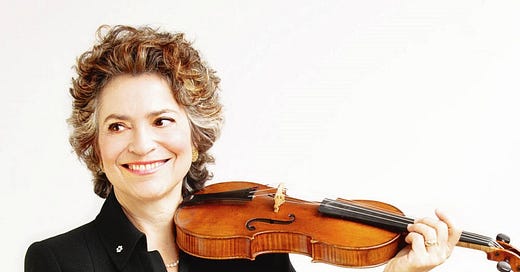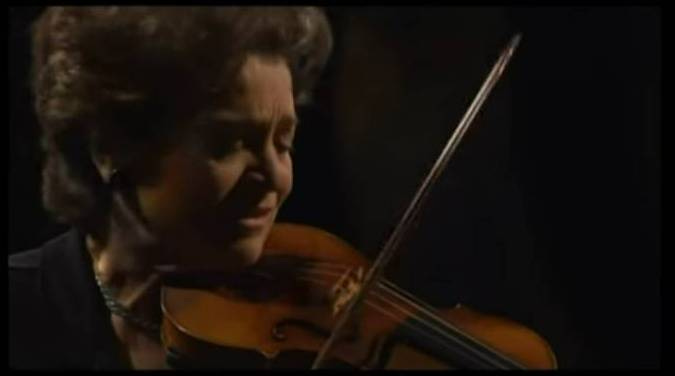After a long hiatus, Tafelmusik returns to live performance next month with a concert dedicated to its former music director of 33 years, the late Jeanne Lamon. The script is by Alison Mackay, she of the baroque-concert-for-the-21st-century format fame which can involve video projections, dancers, spoken poetry or documents, and a lot of history and geography. As this WN piece indicates, the story of Jeanne Lamon will go into those geo-historical directions too, exploring her ancestral ties to the Jewish Amsterdam, noting that Vivaldi’s quarters were minutes away from the violin studio which produced Lamon’s instrument.
The show was written in collaboration with Lamon’s life partner and former Tafelmusik principal cellist, Christina Mahler. Only after Lamon announced her retirement was she comfortable enough to mention their relationship in the media and in public. One of the city’s most prominent violinists, orchestra leaders and historically informed performance (HIP) figures effectively spent her professional life in the closet. A cynic once said to me “but Tafelmusik has corporate sponsors so one can never be too cautious” but Toronto is one of the most liberal cities anywhere, and city’s own Pride Parade is bankrolled by corporate and government sponsors, so I am not entirely buying that. The world of baroque performance in Canada has always had a significant lesbian and bi component, and the biggest orchestra of that world having a concertmaster and principal cellist who are a married couple would not strike as unusual. But this was for some reason kept away from the public eye. Meanwhile, Wagnerian soprano Adrienne Pieczonka was out I think the moment her international career took off, when this information actually could have affected her contracts. But she would not spend her life hiding.
Toronto is a small town with one of everything, and Tafelmusik is its one baroque band – later, period performance band – with stable operating funding from the arts councils. If you can bear with me without snoozing, the biggest obstacle for a music ensemble or a theatre company is bridging from project-to-project funding to the annual operating funding stream. The pot of money for operating funding does not grow significantly year to year, so the places tend to be already occupied and favour the incumbents. It is to the credit of (largely) women who’ve run Tafelmusik over the three decades that they grew the orchestra into the stable organization that it is now. That of course opened it to quarterbacking from the myriad smaller and younger players on the HIP scene that emerged over time. Tafelmusik also offered stable middle class salaries for principal musicians, but the competition for those was fierce and probably left countless freelancers out and grumpy. Moreover, with the forming of the international baroque institute, the orchestra’s leaders now trained the new generations of HIP musicians in North America, but for the extremely tight, almost jobless markets. HIP culture, although probably dominant in the 1500-1800 repertoire in Europe, is still a minority practice in the US and Canada, still needs explaining (its practitioners believe) and advocating for. It is not, in contrast with the situation in Europe, a growing market. The concert halls in Canada and the US have largely been built for modern instruments and large post-Romantic orchestras.
I say its establishment opened it to quarterbacking, but you could go as far as to say it opened it to lashon hara (the world of musicians is as petty and narcissistic as the world of writers, who knew). Take this with a grain of salt, as I have no way of verifying it, but I’ve been told gossip from more than one HIP musician that the private dynamics of the Lamon-Mahler couple affected the workings and the aesthetic choices of the orchestra. (It’s logical that it would, as the couple dynamics do in any similar situation.) I remember distinctly a concert in which Mahler was to start the program with a cello concerto, and everybody was in place except for her. Some minutes passed in patient silence, and finally you could hear the sound of running from under the floorboards, and to the side, and there she was, bursting through the door with her cello, not in the least apologetic for this unusual entry. The orchestra kept their poker faces on. That’s when I thought, oh, there’s something interesting happening here.
To the outside world, the orchestra’s image was that of a slightly stuffy, efficiently run, predictable organization located in a church, a Methodist UCC church at that, sharing quarters with a daycare, a Boomers international social justice organization, and a ballroom practice studio. It had little turnover in key positions over the many years. It performed in a sanctuary with uncomfortable chairs, which all suggested that a concert means observing a sacred activity for which your back and knees need to suffer to some degree. The orchestra’s long-time PR on contract kept a very watchful eye on media output; I was dying to interview Jeanne and do a long, in-depth profile for my opera blog once she announced retirement, but somehow none of my requests ever led to anything, and I concluded neither the PR nor Lamon was particularly eager.
I would have loved to have heard Jeanne speak more about her life, professional and otherwise. Published interviews with her have been few and even fewer are those which are in any way personal. Some of her music talk was rather old-fashioned HIP fare (“we want to play this music as the composers intended it to be heard” is a very uncool thing to say, and she both says it and questions it in this conversation with the Julliard’s HP faculty Thomas Forrest Kelly). I think I’ve met her only once, if memory serves as an admin for an arts foundation a million years ago for a brief minute, and was struck by the intense and I mean intense look in her eyes. The look that kind of says, I am feeling all this much more than y’all will ever know. It’s how she looks while playing the solos in some of the Tafel videos… this one, for example, the two violin concerto by Vivaldi.
And she did look like this in concerts: serious, lost in music, perhaps coming close to being overwhelmed by it. The young’uns would look like it’s all a game, it’s a matter of finger acrobatics, it’s really easy, but she played as if it was a matter of feeling (AND IT SHOULD BE).
I doubt that she left diaries or anything of that sort, and I doubt that any of her close people will write about her – and they should (please do, if any of you are reading). The Wholenote piece about the upcoming concert that I linked to in the first graf promises a section on Monteverdi, because he was important for the period when Jeanne and Christina met – their early relationship, I’m concluding. Monteverdi, let’s remind, is a highly erotic composer, especially in L’Incoronazione. I so hope we get to hear about her inner life now, although it would be very late, too late. While her public persona was withdrawing, even self-effacing, appearing to prefer stability to ambition and risk, I think she was cheekier, badder, madder than we could have ever guessed. *heart on fire emoji*
Anyway, I’ll be there on April 2.





